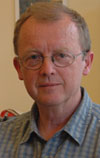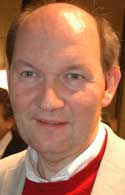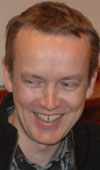SWEDISH SOUTH ASIAN STUDIES NETWORK
• Full programme
|
The Role of South Asia in
the Internationalisation
of
Higher Education
in Sweden
SASNET Workshop 2006
Nobel Forum, Stockholm, 28 – 29 November
Report by Jan Magnusson (assisted by Lars Eklund and Staffan Lindberg)
Dramatic but uneven increase in contacts and cooperation
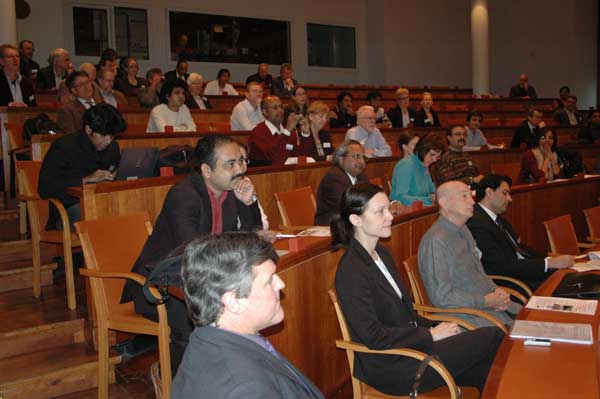 Contacts
and interaction between researchers, teachers and students in Sweden
and South Asia has seen a dramatic but uneven increase during the past
decade. Already existing research cooperation between researchers at
established Swedish universities like Karolinska Institutet, Royal Institute
of Technology (KTH), Chalmers, Uppsala, Lund, Karlstad universities,
etc. has been growing steadily and is now spreading to other universities
and colleges all over Sweden. Most of this is documented on SASNET’s
Internet Gateway (see the page documenting
200 Swedish departments where South Asia related research and/or education
is taking place).
Many of these activities were presented at the workshop in Stockholm,
28-29 November, jointly organised by SASNET, Karolinska
Institutet and the Swedish Institute.
Contacts
and interaction between researchers, teachers and students in Sweden
and South Asia has seen a dramatic but uneven increase during the past
decade. Already existing research cooperation between researchers at
established Swedish universities like Karolinska Institutet, Royal Institute
of Technology (KTH), Chalmers, Uppsala, Lund, Karlstad universities,
etc. has been growing steadily and is now spreading to other universities
and colleges all over Sweden. Most of this is documented on SASNET’s
Internet Gateway (see the page documenting
200 Swedish departments where South Asia related research and/or education
is taking place).
Many of these activities were presented at the workshop in Stockholm,
28-29 November, jointly organised by SASNET, Karolinska
Institutet and the Swedish Institute.
The idea behind the workshop was to learn from each other.
Several financial opportunities exist for interaction between
Sweden and South Asia, from planning grants from Sida SAREC and SASNET,
to project funding from Sida SAREC, the Swedish Research Council,
the Asia Link programme, etc.
Regarding scholarships for foreign
students, such are awarded by the Swedish Institute.
But it is really India that is favoured. Within Sida’s country strategy for India, a joint Indian-Swedish Research Council for Applied Environmental and Information and Communication Technology (ICT) research is about to be set up by the Swedish Institute for Growth Policy Studies (ITPS) in Stockholm. The Swedish Governmental Agency for Innovation Systems (Vinnova) is also involved in the development of joint projects. In both these cases, Indian and Swedish business firms are going to be involved in the development and application of applied research.
It seems Swedish research interaction is growing fairly rapidly with this new Indian “tiger cum elephant”. What about the other countries in South Asia? Through Sida development assistance Bangladesh and Sri Lanka have some elements of research cooperation. Karolinska Institutet has a well-developed programme of cooperation with Aga Khan University in Karachi and Punjab University in Lahore, Pakistan.
Another example of a big and well funded programme
is the research cooperation between Karolinska Institutet, Uppsala
University and some other universities with the International
Centre for Diarrhoeal Research in Dhaka (ICDDR,B), which has involved
the training of doctoral students in sandwich programmes and Masters
students exchange. The programme was commented on at the workshop
by our invited guest, Dr. Rubhana Raqib (read
her presentation).
Further examples include the SPIDER programme
on ICT, which involves Sri Lanka in a major way. For the rest of the
countries of South Asia, Afghanistan, Nepal, Bhutan and the Maldives,
there is practically nothing going on.
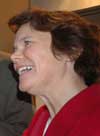
Introductory Session: |
Increasing contacts with India is of course motivated by the fact that India is emerging as one of the major economical and intellectual centres of the world. Its magnitude will soon be felt worldwide not just in the IT sector but also in the field of production of services and goods in the international markets, and in the intellectual, scientific and cultural sectors. In his inauguration speech at the workshop the Swedish Minister of Higher Education, Mr. Lars Leijonborg, confessed that when he worked in Tamil Nadu in the early 1970s he could hardly imagine that this could happen in India. He is now promoting increased contacts with India in education and research.
However, our other invited guest from South Asia, Mr. Sunandan Roy Chowdhury, a journalist and researcher in didactics, warned that the intellectual culture in India may not be as advanced as Swedes and other westerners often imagine. The elite standard of, for example, Indian Institutes of Technology or Managements is not a common phenomenon. There is a myth that scientists trained in the US and Britain return with great potential for new research and innovation (the so called reversed brain-drain), but his impression was that many returned when they had made enough money to live a good life back at home. Indian institutions and companies do not get much added value out of these returnees.
Much research about education in India is still relying on reproduction of western text books and is unrelated to specific Indian issues, he said. Where are ‘corruption studies’ within the discipline of economics? Mr Chowdhury said. Where is the appropriate technology to develop intermediate and practically useful solutions relevant to South Asian conditions?
Mr Chowdhury also suggested
that Swedish cooperation with South Asia could be geared towards
the development of research and education cooperation with ”mofussil” areas
in the sub-continent (mofussil is an Anglo-Indian term for rural
localities as opposed to chief stations), that is, with institutions
and researchers in need of new knowledge and solutions to develop
higher education in backward regions.
Read Mr. Sunandan Roy Chowdhury’s full presentation,
titled ”The Moffusil and the Metropolitan – Higher Education’s
Meandering Paths” (as a pdf-file).
Focused exchange
|
Sweden's government policy for international exchange in higher education and research is changing. The Swedish Institute, a government agency promoting Sweden abroad, is now talking about a global education market where Sweden must attract excellent students and researchers to support its diplomacy, business and tourism. But although Swedish national interests and public diplomacy considerations may be influencing policy making, a large part of the funding for exchange is chanelled through development assistance money.
In South Asia Indian academic institutions are the preferred partners. But recently two large-scale projects in cooperation with the government of Pakistan have been put in the works. Both the projects were presented in the workshop. One of them consists of up to 200 scholarships per year (over a period of 7 years) paid for by the Government of Pakistan, coordinated by the Swedish Institute, and aimed at educating Pakistani Masters and PhD students in Sweden. The other is the Royal Institute of Technology’s (KTH) commission to organize a technical university with 1 000 students in Sialkot, Pakistan. If both of the projects are carried out successfully, higher education exchange between Sweden and Pakistan may be dramatically increased.
Most of the focused exchange in higher education between Sweden and South Asia has been initiated in the past five years. It is bilateral, and almost exclusively on post graduate level (PhD, Masters). With an eye on government policy it is interesting to note that in practice the majority of exchange is going on within a development assistance framework. Several of the programmes have actually been part of larger development assistance initiatives funded by Sida/SAREC, for instance SPIDER (Swedish Programme for ICT in Developing Regions), which organised a split PhD programme for Sri Lankan PhD students between 1999 and 2004.
There are a couple of established so called sandwich programmes in the area of medical sciences like the one between Karolinska Institutet and Aga Khan University in Karachi, Pakistan and between Uppsala University’s International Maternal and Child Health (IMCH) and ICDDR,B, where the partners have shared the training of PhD students. The programmes have been funded by Sida/SAREC and include so called twinning of two students doing related work. These partnerships have been in the area of public health and research in biotechnology, biomedicine, molecular biology and genetic engineering. IMCH and ICDDR,B are now moving away from the sandwich system to a “smorgasbord” of joint research and education ventures.
Since 2002 a number of new exchange programmes between Sweden and South Asia have been started, and several of them were presented in the workshop. One major programme is the collaboration between Linköping University, the University of Skövde and the Pravara Institute of Medical Sciences in Maharastra, India that includes teacher and student exchange as well as joint research projects. In 2004 Uppsala University started an exchange programme about environmental history with Calcutta University in India and in 2005 Karolinska Institutet got involved with a group of partners in training research students in Lahore. The School of Global Studies at Göteborg University does a PhD sandwich programme with University of Peradenyia in Sri Lanka.
Several institutions have received planning grants and are ready to move on to regular exchange programmes but it remains to be seen if they are successful in securing funding for this. An issue here is the time frame where funding agencies, like the Linnaeus Palme programme have a comparatively short perspective on their involvement (up to 8 years maximum) while a programme normally takes 5-7 years just to get established.
The South Asia linked Masters programmes that have been started in Sweden since 2003 have not yet led to any regular exchange of students or faculty. An exception is the Department of Government at Uppsala University that has a Linnaeus Palme funded, small exchange programme with Hyderabad University in India.
Apart from the generic coordination problems and concerns about differences in administrative systems and cultural misunderstanding, a major issue in the exchange between South Asian and Swedish academic institutions that is often brought up is what happens afterwards. A general feeling among programme organizers seems to be that students that come to Sweden to study through focused exchange programmes should have a job to return to after they have received their degree. The scholarship programme Master for Key Personnel, or MKP, run by the Swedish Institute and financed by Sida, could here serve as a model. The MKP programme is open to to university graduates, who are citizens of a developing country and have several years of relevant work experience. Priority is given to applicants who can secure a leave of absence from their jobs which allow them to return upon completion of the studies.
Free mover students to Swedish universities
|
There is a number of scholarships for foreign Masters students
available at the Swedish Institute. In principle, they are faculty neutral.
However, since the usefulness of a particular education to developing
countries has bearing on the selection of the students for scholarships,
the majority of the scholarship holders are to be found in the technical,
natural and medical sciences. The impression of emphasis on technology,
etc. is related to the well-funded research programmes mentioned above
which involve post-graduate exchange programmes of various kinds.
During the last 10 years 97 students/researchers from South Asia spent
a period in Sweden as guest scholarship holder. Mostly the scholarship
had duration of one academic year or more. Of these 39 were from India,
16 from Pakistan, 15 from Nepal, 15 from Bangladesh, and 12 from Sri Lanka.
29 of the grantees were women. 35 studied Medicine, 26 Natural sciences,
19 Technology and 2 Agriculture.
Sweden has just recently started to attract larger groups of non-European students to its Masters programmes, one reason being the absence of tuition fees, which makes Sweden a cheap alternative for the growing numbers of students from South Asia (especially in technology). Another reason is the rather harsh treatment of Muslim students in some countries after 9/11 . Chalmers and the Royal Institute of Technology, for example, recruit students from Bangladesh and Pakistan. A fair number of the students continue their studies as PhD candidates promising a strengthening of the research capacity of these institutions in the near future.
New entrants are, for example, Blekinge Institute of Technology, that has managed to recruit more than a thousand such students to its various Masters programmes. Borås University College is another example, but with a much smaller number of students. A problem in the recruitment is the students’ slim chances of getting admitted to post-graduate studies as well as a lack of job opportunities in Sweden after they have received their degree.
The overall number of South Asian masters students is still small, below 1 000, but makes up a substantial part of the ca 1 600 non-European students currently in Sweden.
Still, outside technology, natural sciences and possibly medicine, South Asian students at Swedish universities and colleges are few and scattered around various institutes. Their numbers will depend on the future development of internationally competitive Masters programmes in the humanities and social sciences.
In the discussion at the workshop several speakers pointed out the many problems facing foreign masters students, such as difficulties in getting accommodation and getting along culturally in a strange environment. Another major problem is the difficulty in getting a visa for studies in Sweden.
Sending Swedish students to South Asia
|
Sending Swedish students to South Asia in a more organized way most often includes forming partnerships with South Asian academic institutions. Ideally this should be a two-way process where both partners are in it for the academic benefit, and with a high level of reciprocity.
There are still comparatively few such programmes at Swedish universities. On the other hand a couple of these programmes – Karlstad University’s India Programme and Örebro University’s Sweden-India Project – are well-established, long-running and have been sending students to South Asia for years. They have set up their own structures in India, including employees and housing facilities for the students.
Some more recent programmes include the South Asian studies track of the Masters Programme in Asian Studies at Lund University, Uppsala University’s exchange programmes with Hyderabad University and Calcutta University, and the Nordic Centre in India’s (NCI) summer programme at Hyderabad University. Some of the programmes are small-scale like Uppsala University Department of Government’s two students/semester frequency while others, like NCI’s summer programme include up to around 20 students/year. Still, the number of Swedish students involved is very small, especially if we compare with Denmark and Norway. In Norway, for example, Kulturstudier runs a Programme in peace and conflict and religious studies, where students go to Pondicherry in India for a full semester. The programme was presented at the workshop. It is based on a different model and does not involve any exchange. More than 800 students have participated in the programme.
So far all of these programmes seem to have been successful although a few of them have experienced problems commonly associated with cooperating across cultures and academic systems. However, in the discussion it was pointed out that there has been too little emphasis on learning South Asian languages.
A couple of other basic issues are at hand. They are, not surprisingly perhaps, connected to differences in funding conditions. Swedish academic institutions are comparatively well funded in their outgoing activities while their South Asian partners often lack matching funding. This creates a reciprocity problem where South Asian partners may find it hard to benefit on the programme except for financially. They simply do not have the means to reciprocate.
In a few cases Swedish institutions have experienced that South Asian partners have been mainly interested in the economic benefit of receiving students and less interested in the academic benefit. This means, for instance, that it has been hard to motivate the South Asian partner to share the work in writing applications for student exchange programme such as the Linnaeus Palme grant. Planning grants are used for initial meetings between the partners but one of the problems is to get people to remain involved after these grants have been exhausted.
A third issue is that almost all Swedish students that go to South Asia as part of their studies go to India. This pattern reflects student interest, regional security issues as well as the perceived quality of academic institutions in other South Asian countries. So when we are speaking about sending students to South Asia we are still speaking about sending them to India.
Looking at the experiences of Swedish students who have spent some time at a South Asian institution there are a couple of prevalent perspectives. Students who have shared their experience from the smaller programmes in India emphasize the value of living on campus and socializing with Indian students. But they also report some issues in student-teacher relations, which is probably a result of academic cultural differences. Finally, an issue that was raised at the workshop is that of “academic tourism” where the Swedish students stay together as a group and mix academic projects with conventional tourist activities, outside an established academic institutional framework and with limited contacts with Indian students. Reciprocity is then reduced to a minimum. Academic tourism, however, seems to be predominantly connected with programmes where students pay a full fee covering all of the expenses involved.
Final discussion
|
The discussion of the role of South Asia in the internationalization of higher education can be approached as a national project that brings the question of what is good for Sweden to the fore. But higher education can also be seen as an institutional project and a question about what is good for a single university. Perhaps it is the choice of perspective that is at the root of the current debate over the recruitment of foreign students to some of the Swedish universities as a business objective. In the present system a Swedish university can increase government funding by admitting large numbers of foreign students. Critics argue that this approach deflates the quality of education and students and is a misuse of tax money that could have been put to better use. Others might object that picking only the good and the right students from the sub-continent to study in Sweden is a tricky issue since it may have a colonial ring to it, and can offset the fairness of the system.
Why should taxpayers fund the education of, for instance, Indian engineers that will not enter the Swedish job market after their graduation? From a government point of view educating foreign students in Sweden has fallen back on the rationale that internationalization of higher education is an issue of strategic importance in the promotion of Sweden abroad. For the individual university foreign students and international exchange enrich the academic environment by providing multicultural and multinational perspectives on campus. What seems important at the end of the day is to have the competence to evaluate applications correctly and to have good support systems for foreign students in Sweden in place.
The introduction of fees from foreign students from outside the European Union may change all of this. This was clear from Erland Ringborg’s presentation. Fees will relieve taxpayers from the cost and open up for business. But will it increase quality? Will it decrease the number of students? The idea of fees seems to have been accepted by most actors in the higher education sector. Technically, the bill can be introduced in the Swedish parliament in spring 2007 and implemented 2008/2009. Most indications point to a ”soft” introduction through a transition period when the universities are allowed keep some of the money.
It seems, of course, paradoxical to try and increase the number of students by starting to charge for something that used to be free. Critics fear that the number and quality of students will drop drastically. But a positive view on the consequences is that fees will allow Swedish institutions to increase the quality of education to compete better in the global education market and that the students who decide to study in Sweden will be more committed. A major issue when it comes to South Asia is that fees will make Swedish education too expensive for many students. A fee system must thus be combined with an extensive system of scholarships.
In the discussion K.V.S. Prasad from Chalmers stressed the need to solve real problems in international Masters programmes, like housing and cultural expectations, before marketing the programmes.
As a final note one can ask how ready Sweden is to follow
the route outlined above. The introduction of two year Masters Programmes
along the lines of the Bologna model, which are fully recognised and
accepted internationally, has just come about in Sweden and might still
need some time to become established.
When it comes to academic interaction
with South Asia we are also still faced with the challenge to make the
region relevant to our own society.
by Jan Magnusson,
(assisted by Lars Eklund and Staffan Lindberg)
SASNET - Swedish South Asian Studies Network/Lund University
Address: Scheelevägen 15 D, SE-223 70 Lund, Sweden
Phone: +46 46 222 73 40
Webmaster: Lars Eklund
Last updated 2011-04-08
